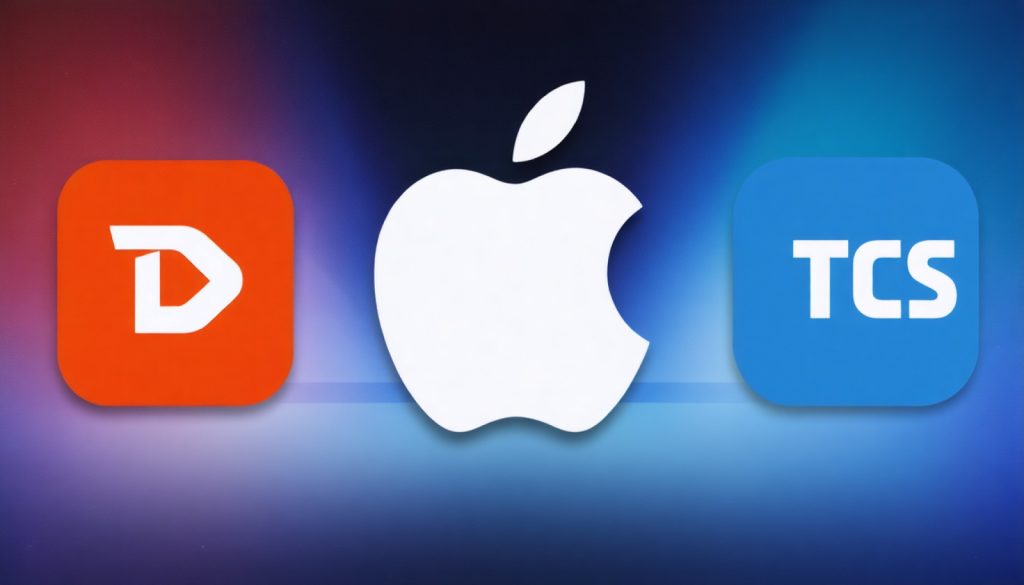
- Apple captures a 19% global smartphone market share in Q1 2025, surpassing Samsung and demonstrating strategic growth.
- Samsung targets India with the Galaxy M56 5G, appealing to budget-conscious millennials with advanced features at a competitive price.
- TCS becomes the world’s second-largest IT services company, surpassing $30 billion in revenue, emphasizing adaptability and customer focus.
- Infosys cuts 240 trainees due to internal assessment failures, highlighting pressures on new tech professionals.
- Potential Google layoffs in Hyderabad and Bengaluru suggest industry volatility and challenges within tech workforces.
- Firms continue to drive innovation, impacting market dynamics and evolving the concept of progress amidst global uncertainty.
When the world’s eyes turn towards innovation, Apple once again steals the spotlight, ascending to the top of the global smartphone market chart for the first quarter of 2025. Surpassing Samsung with a razor-thin margin, Apple captures a 19% market share, proving itself to be more than a purveyor of sleek design—it’s a titan of steady, strategic growth. As Counterpoint Research reveals, this upsurge is supported by emergent markets and China’s government-induced tech renaissance, even as global economies tiptoe on tightropes of uncertainty and simmering trade disagreements.
While Apple basks in the limelight, Samsung has set its sights on India, introducing the Galaxy M56 5G with features that dazzle—think a 50MP triple rear camera and a fortified Gorilla Glass Victus+ body, all for the starting price of ₹24,999. This move seems tailored to woo India’s tech-savvy, budget-conscious millennials who crave cutting-edge technology without a colossal price tag.
On a different front, TCS secures its place as a towering colossus of the IT world, crossing the $30 billion revenue threshold. Within its storied corridors, TCS now stands as the world’s second-largest IT services company. Under the leadership of CEO K Krithivasan, the firm’s bold path underscores a dedication to staying nimble and customer-focused—a testament to the strength of its foundational philosophies like the ‘Perpetually Adaptive Enterprise.’
However, not all narratives are woven with triumph. Infosys makes headlines for dismissing 240 trainees who couldn’t meet internal assessment benchmarks. This is the second wave of such lay-offs this year, raising questions about the pressures that today’s fierce tech landscape exerts on budding professionals.
Meanwhile, whispers of potential layoffs at Google loom large, particularly concerning their teams in Hyderabad and Bengaluru. As the industry braces for these anticipated cuts, broader reflections grow louder on the volatility weaved into the fabric of today’s tech workforce.
Amidst the shifting sands of global technology trends, businesses and consumers alike cling to constant change and resilient adaptation. As firms fight for innovation and relevance, they create ripple effects that don’t just transform markets, but redefine the essence of progress itself.
Why Apple’s Victory in the Smartphone Market Signals a New Era
Apple’s Ascension in the Smartphone Market
For the first quarter of 2025, Apple has surged past Samsung to become the leader in the global smartphone market, capturing a 19% market share. This is no small feat, considering the competitive landscape and the challenges presented by global economic uncertainties and trade disagreements.
Key Factors Behind Apple’s Growth:
1. Innovative Product Offerings: Apple’s strong lineup, including the latest iPhone models, continues to captivate consumers with innovations in camera technology, battery life, and user interface.
2. Strategic Market Penetration: Leveraging growth in emerging markets and benefitting from China’s government-backed tech initiatives, Apple has effectively broadened its reach.
3. Brand Loyalty and Ecosystem: Apple’s solid ecosystem—from hardware to services like iCloud and Apple Music—ensures high customer retention and cross-product engagement.
For more details, visit Apple.
Samsung Strikes Back: The Indian Market Strategy
Samsung, undeterred by its slight dip in market share, is focusing on India with the launch of the Galaxy M56 5G.
Features and Specs:
– Triple Rear Camera: A powerful 50MP main sensor aimed at photography enthusiasts.
– Durable Design: The use of Gorilla Glass Victus+ offers premium durability.
– Affordable Pricing: Starting at ₹24,999, it positions Samsung as a competitor in the budget segment, appealing to price-sensitive millennials in India.
Samsung’s strategy in India is crucial as it’s one of the fastest-growing smartphone markets. Discover more at Samsung.
TCS’s Milestone: Crossing $30B in Revenue
Tata Consultancy Services (TCS) has cemented its position as the world’s second-largest IT services firm, surpassing the $30 billion mark.
– Adaptation and Innovation: TCS’s agile approach and client-centric strategies have allowed sustained growth and adaptability.
– Industry Leadership: Under CEO K Krithivasan, TCS is focusing on emerging technologies and expanding service offerings.
Explore their latest achievements at TCS.
Challenges in the Tech Industry: Infosys and Google Layoffs
As the tech industry evolves, workforce volatility presents challenges:
– Infosys Layoffs: Dismissing 240 trainees for failing assessments marks a concern for the pressures within today’s tech sector.
– Google Rumors: Potential layoffs in India raise questions about job security and industry stability.
Actionable Tips
1. Stay Updated: Follow industry leaders and news sources to keep up with market trends and company strategies.
2. Enhance Your Skills: Continuous learning is vital, whether through online courses or certifications, to remain competitive in the tech job market.
3. Leverage Ecosystems: For consumers, considering ecosystem integration when purchasing new tech can enhance usability and product value.
4. Diversify Investments: Businesses should diversify to mitigate risks associated with market fluctuations and economic uncertainties.
Closing Thoughts
As Apple, Samsung, and TCS lead the charge, understanding the dynamic shifts in the tech landscape can help both businesses and consumers navigate with insight and foresight. For more insights, visit Counterpoint Research.



